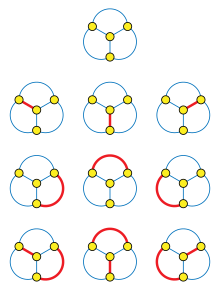Hosoya index

The Hosoya index, also known as the Z index, of a graph is the total number of matchings in it. The Hosoya index is always at least one, because the empty set of edges is counted as a matching for this purpose. Equivalently, the Hosoya index is the number of non-empty matchings plus one. The index is named after Haruo Hosoya. It is used as a topological index in chemical graph theory.
Complete graphs have the largest Hosoya index for any given number of vertices; their Hosoya indices are the telephone numbers.
History
This
In his article, "The Topological Index Z Before and After 1971," on the history of the notion and the associated inside stories, Hosoya writes that he introduced the Z index to report a good correlation of the
Example
A linear alkane, for the purposes of the Hosoya index, may be represented as a path graph without any branching. A path with one vertex and no edges (corresponding to the methane molecule) has one (empty) matching, so its Hosoya index is one; a path with one edge (ethane) has two matchings (one with zero edges and one with one edges), so its Hosoya index is two. Propane (a length-two path) has three matchings: either of its edges, or the empty matching. n-butane (a length-three path) has five matchings, distinguishing it from isobutane which has four. More generally, a matching in a path with edges either forms a matching in the first edges, or it forms a matching in the first edges together with the final edge of the path. This case analysis shows that the Hosoya indices of linear alkanes obey the recurrence governing the
The largest possible value of the Hosoya index, on a graph with vertices, is given by the complete graph . The Hosoya indices for the complete graphs are the telephone numbers
These numbers can be expressed by a summation formula involving factorials, as
Algorithms
The Hosoya index is
Notes
- .
- ^ a b Hosoya, Haruo (2002), "The topological index Z before and after 1971", Internet Electronic Journal of Molecular Design, 1 (9): 428–442.
- ^ Internet Electronic Journal of Molecular Design, special issues dedicated to Professor Haruo Hosoya on the occasion of the 65th birthday: Volume 1 (2002), Number 9 — Volume 2 (2003), Number 6.
- PMID 16201918.
- S2CID 189854401.
- ISBN 978-0-85626-454-2.
- .
- ISBN 978-3-540-48381-6.
- ^ Jerrum, Mark; Sinclair, Alistair (1996), "Chapter 12: The Markov chain Monte Carlo method: an approach to approximate counting and integration", Approximation Algorithms for NP-hard problems (PDF), PWS Publishing, pp. 482–520
References
- Roberto Todeschini, Viviana Consonni (2000) "Handbook of Molecular Descriptors", ISBN 3-527-29913-0






